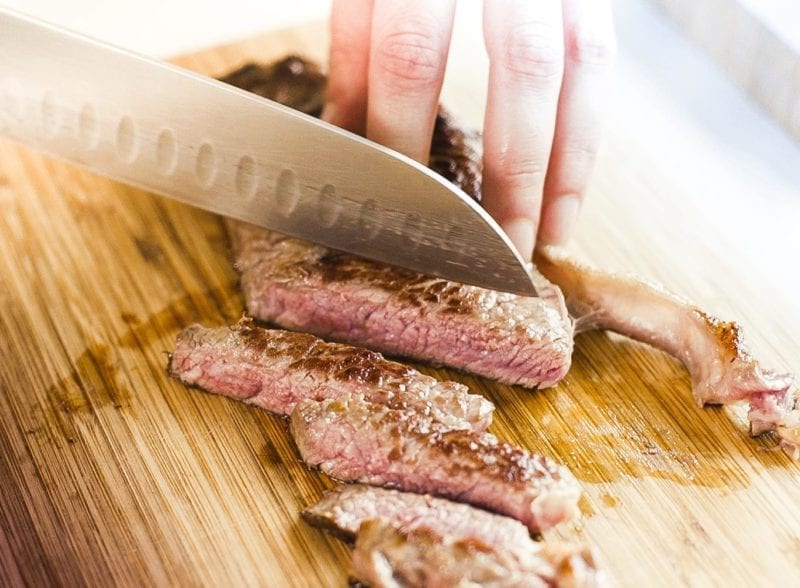How To Cook Meat Safely

Forget ‘know your onions’ – this post is all about making sure you really know your meat. Consider it your one stop shop for information about the not-so-thrilling, but very important subject of meat safety…
When it comes to cooking your Gousto recipes, your safety is always our top priority. We only use carefully selected, quality assured British fresh meat in our recipes, but cooking any meat has to be managed with care – that’s why I’ve put together these guidelines on how to safely cook and store your meat.
When meat is cooked thoroughly, the harmful bacteria that’s in some types of raw meat gets destroyed. However, oven temperatures and the thickness of meat cuts can vary (which means cooking times may also vary), so always check the specific instructions in our recipes to ensure your meat is cooked properly.
General Advice:
- Take your meat out of the fridge for a few minutes before cooking to bring it to room temperature, but never leave it out for a long time – especially in hot weather!
- After cooking, rest joints of meat like steak, chicken breast and roasts for a few minutes before cutting – this helps the meat to become tender.
- Always fry meat starting in a pan that’s already hot; it can be turned down once the meat starts to cook, if needed.
Storing
Storing meat properly is important to avoid food poisoning and cross contamination with other foods.
- Always refrigerate as soon as possible after delivery. Meat can be stored in the fridge for a few days, and your fridge temperature should be at 5°C or below.
- Eat within the ‘use by’ date.
- If meat has been in the fridge for a while and you’re unsure about its freshness, don’t risk it – throw it away! Unpleasant odour and greying in colour are signs that meat’s past it’s best. You may find that some meat that has been vacuum packed will have a slightly unpleasant odour when it’s first unwrapped; this should go away after a few minutes – it doesn’t then it may not be fresh enough to eat.
- Keep meat packaged until just before use and store on the bottom shelf of your fridge, away from other foods. With leftover meat, make sure it’s re-wrapped and you stick to the original ‘use by’ date. If packaging leaks, put it in a plastic container or on a plate.
- Freeze meat within the ‘use by’ date, wrapping it well to avoid cross contamination, and labelling with the date. Your freezer temperature should be around -18°C.
- Defrost meat in the fridge for 24 hours before cooking, and never refreeze defrosted meat.
- Raw meat can contain harmful bacteria which can spread onto anything it touches, including worktops, tables, chopping boards, and knives. Make sure these are thoroughly cleaned after use. Use one chopping board for cutting meat and another for vegetables or other foods.
- Always wash your hands thoroughly with soap and water after handling any meat.
Now let’s look at some specific types of meat…

Storing
Can usually be refrigerated for 2-3 days, but always check the use-by date.
Freeze for up to 6 months and never refreeze once defrosted.
Cooking
Chicken must be thoroughly cooked through. To check this, pierce the thickest part with a skewer, then remove the skewer and press it against the meat so the juices run out. If the juice is pink or red it’s not cooked! If chicken appears at all pink, then it’s undercooked.
Preparation
You shouldn’t rinse raw chicken under a tap, as the water from rinsing can spread the bacteria onto hands, work surfaces, clothing, and cooking equipment.
 Storing
Storing
Can usually be refrigerated for 2-3 days, but always check the ‘use by’ date.
Freeze for up to 6 months and never refreeze once defrosted.
Mince and sausages can usually be frozen for up to 4 months.
Cooking
Pork must be thoroughly cooked through. To check if your pork is cooked, use the same technique as with chicken. This technique can be used for pork sausages and burgers too!
 Storing
Storing
Can usually be refrigerated for 2-3 days, but always check the ‘use by’ date.
Freeze for up to 6 months and never refreeze once defrosted.
Mince and sausages can usually be frozen for up to 4 months.
Cooking
Lamb can be served pink depending on how you like it (apart from mince and sausages), for example rare, medium rare or well done.
Lamb mince burgers and sausages should be thoroughly cooked through. If you see pink or red juice running out of them, they’re not properly cooked.

Storing
Beef can usually be refrigerated for 2-3 days but., always check the ‘use by’ date. Freeze for up to 6 months and never refreeze once defrosted.
Mince can be frozen for up to 4 months.
Cooking
Beef, including burgers, can be served pink, depending on how you like it. Mince used in Bolognese or a casserole will be more tender the longer you cook it for.




 MENU
MENU CLOSE
CLOSE